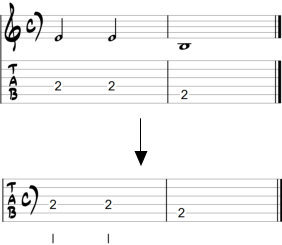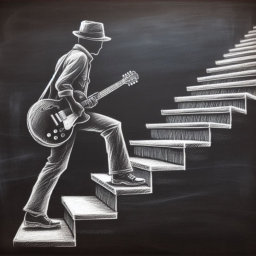
home \ tutorials \ reading guitar tabs
Tutorial: Reading Guitar Tabs Basics
Tablature (abbreviated “Tabs”) is an easy-to-learn alternative to reading notes. It is easier than “normal” reading notes. While note notation is universal - for all instruments, tabs are only for guitar. The basics of tablature are quite simple: there are six lines, each line represents a string. The top line represents the highest-sounding string (the high E), the bottom line represents the lowest-sounding string (the low E). This is the basics:

As with normal music notation, vertical lines are used to indicate bars. Double (fat) lines indicate the start and end, a colon means repeat:

To learn more about bars and general rhythm notation, please read the rhythm notation tutorial.
Numbers indicate which fret on which string you should press.
A "0" stands for an open string: let the string ring without pressing a fret.
In the following example, you first play an open low E string, then the second fret on the A string, then the second fret on the D string, and finally the first fret on the G string.
Note that you play these notes in sequence, so not at the same time!

Rhythm in tabs
In the rhythm notation tutorial you can read about rhythm notation in regular music notation. In general, there are two ways of writing rhythm in guitar tabs.
The first way is by showing regular sheet music above the tabs, as in the example below:

An other way to show the rhythm is by adding the same rhythm indication to the tabs as is done in sheet music:

As you can see, stems and flags are "attached" to the fret numbers. Rests are placed directly in the tabs.
Quarter note have a full stem,all the way to the fret number. For half notes, the stem is halved. Whole notes do not have a stem at all:

Fingers
Sometimes small digits are placed below the fret numbers to give a suggestion on which finger to use (1 = index finger, 2= middle finger, 3 = ring finger, 4 = little finger).

Simultaneous tones
Sometimes you have to play multiple tones at the same time, e.g. when playing double stops (=two tones at the same time), or chords.
In that case the fretnumbers are shown vertically below or above each other:


Everything on guitartutorials.nl is completely free to access. If you’d like to support my work and help keep this resource growing, any and all donations are deeply appreciated. Thank you, and happy playing!